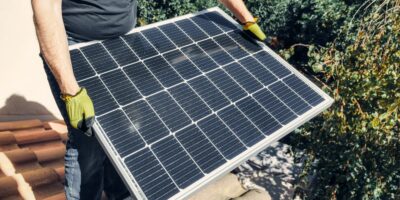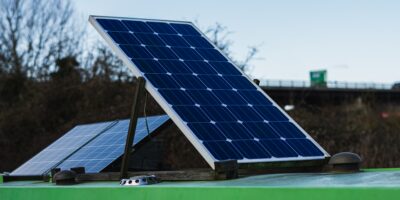As a clean energy blogger, I understand the importance of educating homeowners about the potential of solar energy for heating and cooling systems. This comprehensive article will explore various aspects of solar energy for heating and cooling systems, divided into essential sections for easy navigation.
Solar Energy for Heating
Solar energy can be harnessed to provide space and water heating for homes, offering an eco-friendly, cost-effective alternative to traditional heating methods. Different types of solar thermal collectors are available, each with its benefits in terms of efficiency, cost-effectiveness, and ease of maintenance.
Types of Solar Thermal Collectors
- Flat Plate Collectors: These collectors consist of a flat, dark-colored plate that absorbs sunlight and transfers the heat to a fluid (air or liquid) flowing through tubes attached to the plate. Flat plate collectors are affordable and suitable for most residential applications.
- Evacuated Tube Collectors: These collectors use a series of vacuum-sealed glass tubes to absorb sunlight and transfer the heat to a fluid flowing through a central manifold. Evacuated tube collectors are more efficient than flat plate collectors but can be more expensive and challenging to maintain.
- Unglazed Solar Collectors: These collectors are made from simple, unglazed materials, such as plastic or rubber, primarily used for pool heating. Unglazed collectors are the least expensive option but have lower efficiency than glazed collectors.
Benefits of Solar Heating
Homes that have successfully utilized solar heating systems enjoy several benefits, including:
- Reduced Energy Consumption: By harnessing the sun’s energy to heat their homes, homeowners can significantly reduce their reliance on fossil fuels and grid-supplied power, leading to lower energy bills.
- Lower Carbon Footprint: Solar heating systems produce no greenhouse gas emissions during operation, helping homeowners minimize their environmental impact and contribute to global efforts to combat climate change.
- Easy Maintenance: Solar heating systems generally require minimal maintenance, as they have few moving parts and are designed to withstand harsh weather conditions.
Solar Energy for Cooling
Solar energy can also power home cooling systems, offering an environmentally friendly and cost-effective alternative to traditional air conditioning systems. Solar-powered fans and air conditioners can help homeowners reduce their energy consumption, lower their carbon footprint, and improve indoor comfort during the hot summer.
Types of Solar Cooling Technologies
- Solar Ventilation Fans: These fans use solar panels to power their motors, providing energy-efficient ventilation and helping to maintain comfortable indoor temperatures. Solar ventilation fans can be installed in attics, crawl spaces, or other home areas where improved air circulation is needed.
- Solar Air Conditioners: Solar air conditioners use solar energy to power their compressors, responsible for cooling the refrigerant and providing cool air to the home. There are two main types of solar air conditioning systems: photovoltaic (PV) powered systems, which convert sunlight into electricity to power the air conditioner, and solar thermal systems, which use solar collectors to heat a fluid that drives an absorption chiller or desiccant cooling system.
Benefits of Solar Cooling
Homes that have successfully adopted solar cooling solutions enjoy several benefits, including:
- Reduced Energy Bills: Solar cooling systems can significantly reduce the amount of grid-supplied power needed to cool your home, resulting in lower energy bills during the hot summer months.
- Improved Indoor Comfort: Solar cooling systems can help maintain comfortable indoor temperatures and reduce the need for conventional air conditioning, improving indoor air quality and reducing the risk of respiratory issues associated with poor indoor air circulation.
- Environmental Impact: Like solar heating systems, solar cooling systems produce no greenhouse gas emissions during operation, helping homeowners minimize their environmental impact and contribute to global efforts to combat climate change.
Key Considerations for Solar Heating and Cooling Systems
Before investing in solar heating and cooling systems, homeowners should consider several factors that can impact the performance, cost-effectiveness and overall benefits of these systems:
- Size and Orientation of Your Home: The size and orientation of your home can affect the amount of sunlight available for solar heating and cooling systems and the overall efficiency of these systems. South-facing roofs or yards typically receive the most sunlight, making them ideal for solar installations.
- Local Climate Conditions: The climate in your area can influence the performance and potential benefits of solar heating and cooling systems. Solar heating and cooling systems may be more effective and cost-efficient in areas with abundant sunshine and mild temperatures than in regions with limited sunlight or extreme temperature fluctuations.
- Energy Consumption Patterns: Understanding your household’s energy consumption patterns can help you determine the appropriate size and design of your solar heating and cooling system. This includes considering factors such as the time of day when you use the most electricity and any seasonal variations in your energy usage.
Financing Options and Incentives for Solar Heating and Cooling Systems
There are several financing options and incentives available for homeowners looking to invest in solar heating and cooling systems:
Loans
Homeowners can obtain loans from banks or other financial institutions to finance the purchase and installation of a solar heating or cooling system. These loans typically require a down payment and have interest rates that vary based on the borrower’s creditworthiness.
Tax Credits and Incentives
Governments often offer tax credits and incentives to encourage homeowners to invest in solar heating and cooling systems. In the United States, the federal Investment Tax Credit (ITC) allows homeowners to claim a tax credit worth 26% of the cost of their solar system in 2021, decreasing to 22% in 2023. Many states and local governments also offer additional incentives, such as property tax exemptions, rebates, and low-interest financing options.
Choosing the Right Solar Heating and Cooling System for Your Home
When selecting a solar heating and cooling system for your home, consider factors such as:
- System Size: The size of the solar heating or cooling system should be sufficient to meet your household’s energy needs and preferences, considering factors such as the size of your home, local climate conditions, and energy consumption patterns.
- Efficiency: The efficiency of the solar heating or cooling system refers to the amount of energy that can be extracted from the system relative to the amount of energy input. Higher efficiency systems will provide more usable power and greater cost savings over time.
- Installation Costs: The cost of installing a solar heating or cooling system can vary depending on factors such as the type of system, the complexity of the installation, and local labor rates. Compare quotes from multiple solar professionals to ensure you get the best investment value.
- Maintenance Requirements: Solar heating and cooling systems typically require minimal maintenance, but it’s important to consider any ongoing costs associated with maintaining and monitoring these systems, such as regular inspections, cleaning, and professional servicing.
Maintenance and Monitoring of Solar Heating and Cooling Systems
Regular maintenance and monitoring of your solar heating and cooling system are crucial to ensure its optimal performance and longevity. Here are some tips for keeping your solar heating and cooling system in top condition:
Monitoring Your System’s Performance
Regularly monitoring your solar heating and cooling system’s performance can help you identify any issues or inefficiencies that must be addressed. Many solar thermal collectors and solar-powered air conditioners come with built-in monitoring software, which allows you to track your system’s energy production, consumption, and overall performance through a smartphone app or web portal.
Routine Inspections and Cleaning
Conduct routine inspections of your solar heating and cooling equipment, including solar collectors, fans, and air conditioners, to check for any signs of wear or damage. Ensure that your solar panels and thermal collectors are free of dirt, debris, or other obstructions that could reduce their efficiency, and clean them as needed using a soft brush and water.
Professional Maintenance and Repairs
While solar heating and cooling systems generally require minimal maintenance, addressing any issues promptly is essential to ensure optimal energy production. If you notice a significant drop in your system’s performance or encounter any problems with your solar equipment, contact a certified solar professional to diagnose the issue and perform any necessary repairs or maintenance.
Conclusion
Solar energy for heating and cooling systems offers homeowners an eco-friendly, cost-effective alternative to traditional heating and cooling methods. By harnessing the sun’s energy to heat and cool their homes, homeowners can significantly reduce their energy consumption, lower their carbon footprint, and enjoy improved indoor comfort throughout the year.
By understanding the key considerations, financing options, and industry standards involved in solar heating and cooling installations and by working with experienced solar professionals, homeowners can make the most of this clean, renewable energy source and contribute to a brighter, greener future.
Embracing solar energy for heating and cooling requires careful planning, informed decision-making, and ongoing commitment to monitoring and maintaining the solar system. By taking these steps and adopting solar energy for heating and cooling, homeowners can enjoy the many benefits of clean, renewable power while positively impacting the environment and their local community.



